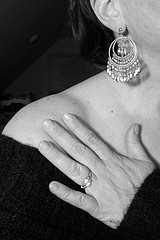
Mary and Child with Sts Mary Magdalene and Catherine
by Alvise Vivarini
1504
Oil on canvas, 89 x 129 cm
The Hermitage, St. Petersburg
THE SAINTLY SINNER
by JOAN ACOCELLA
The two-thousand-year obsession with Mary Magdalene.
Issue of 2006-02-13 and 20
Posted 2006-02-06 The New Yorker
The Catholic Church presumably has enough on its hands right now without worrying about popular fiction, but the Holy See cannot have failed to notice that Dan Brown’s “The Da Vinci Code,” a novel claiming that Jesus was married, has been on the Times best-seller list for almost three years. (Its message will soon spread more widely: the paperback is due out next month, and the movie version will be released in May.) Brown is by no means the first to have suggested that Christ had a sex life—Martin Luther said it—but the most notorious recent statement of the theory was a 1982 book, “Holy Blood, Holy Grail,” by Michael Baigent, Richard Leigh, and Henry Lincoln. “Holy Blood,” which was one of the main sources for “The Da Vinci Code,” proposes that after the Crucifixion Jesus’ wife, with at least one of their children, escaped to France, where their descendants married into the Merovingian dynasty and are still around today. Nobody knows this, though, because, according to the authors’ scenario, the truth has been kept under wraps for a thousand years by a secret society called the Priory of Sion. The book offers a fantastically elaborated conspiracy theory—involving Leonardo da Vinci, Isaac Newton, Victor Hugo, and Jean Cocteau (all “grand masters” of the Priory of Sion), plus Emma Calvé and various others—that cannot be briefly summarized, but the upshot is that the Priory may now be ready to go public with its story. The authors warn that the organization may intend to set up a theocratic United States of Europe, with a descendant of Jesus as its priest-king but with the actual business of government being handled by some other party—the Priory of Sion, for example.
And who is the woman who caused all this trouble? Who married Jesus and bore his offspring and thereby laid the foundation for the overthrow of post-Enlightenment culture? Mary Magdalene.
"Mary Magdalene is one of several women named Mary who appear in the four canonical Christian gospels: Matthew, Mark, Luke, and John. She is said in the Gospels to have been relieved of seven demons, to have supported Jesus' ministry financially, and to have witnessed the crucifixion and resurrection. Mary Magdalene was also important to the Gnostics, a category that collectively describes several early Christian sects that placed an emphasis on salvation through knowledge. She appears in several texts that are classified as "gnostic" as a favorite disciple, visionary, and leader. "

No comments:
Post a Comment